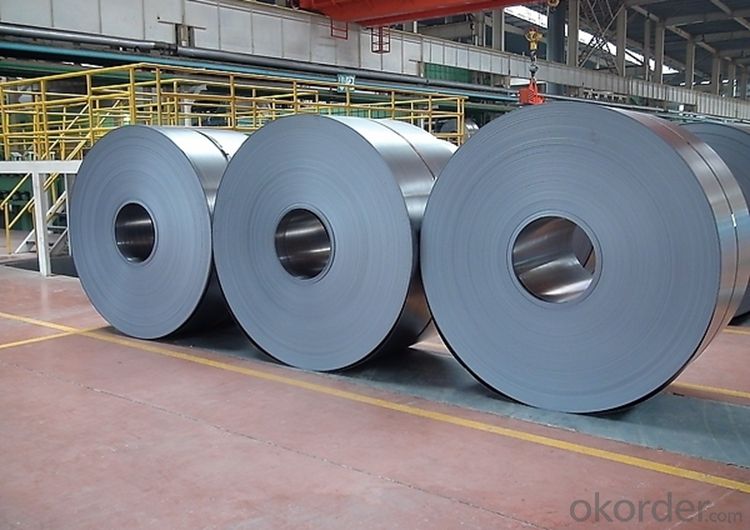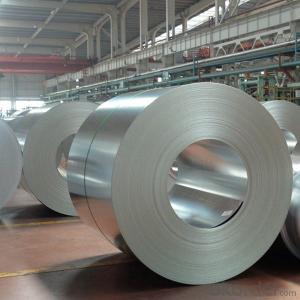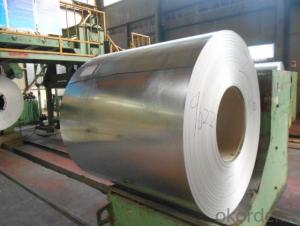Stainless Steel Made in China Hot Rolled Steel Coils
- Loading Port:
- Tianjin
- Payment Terms:
- TT OR LC
- Min Order Qty:
- 20 m.t.
- Supply Capability:
- 20000 m.t./month
OKorder Service Pledge
OKorder Financial Service
You Might Also Like
Item specifice
Products Description for Stainless Steel Coils/Sheets:
Product | stainless steel coils/plates/sheets | ||
Discharge Port | Any Port, China | ||
Size | Coils | Cold Rolled: | Thickness0.3-8mm,Width:280-2100mm |
Hot Rolled : | Thickness3-14mm,Width:650-2100mm | ||
Plates | Thickness2-80mm,Width:1500-3000mm | ||
Coil Weight | About 20 Tons | ||
Grade | 201,202,304/304L/304H,316/316L/316H,321/H,310S,409/L,430 etc. | ||
Technique | Hot Rolled/Cold Rolled | ||
Finish | 2B, BA, 2D, No1, No2, No4,NO.8,SB etc | ||
Edge | Mill Edge / Slitting Edge | ||
Package | In bundles, or as customer's requirement | ||
Place of Origin | Made in China | ||
MOQ | 20 Tons | ||
Description for Stainless Steel Coils/Sheets:
Prodcut:Stainless Steel Coil
Thinckness: 0.20mm-8.0mm
Width:1000mm, 1219mm(4 feet), 1250mm, 1500mm, 1524mm(5 feet),
1800mm, 2000mm, 2200mm, 2500mm,and customizable
Ni:0.8~1.2% Cu:1.4~1.5% Cr:14
Standard: ASTM, JIS, GB, BS, DIN etc
Grade: 200series&300series&400series
Surface finish: 2B, BA, 8K, 6K, Mirror Finished, No1, No2, No4, Hair Line with PVC
Manufacture technology: cold rolled/hot rolled
Thickness Tolerance: +/-0.1mm
Width Tolerance: +/-10mm
200 Seriers: 201,202
300 Seriers: 301, 304, 304L, 316L, 309, 310S,321
400 Seriers: 410, 410S, 409L,430
Detail picture for Stainless Steel Coils/Sheets


Packaging & Delivery for Stainless Steel Coils/Sheets:
Packaging Detail Standard export packing or following customer's demand
Delivery Time: Within 30-40 days after deposit or according to the order quantity
Export Markets for Stainless Steel Coils/Sheets:
Our target market is the international market. Every year we export most of products to countries like India, Pakistan, South Korea, Brazil, Australia, South Africa, Spain, Sri Lanka, Taiwan, Hong Kong, etc.
FAQ for Stainless Steel Coils/Sheets:
Q:What are the advantages of your company ?
A: We have many professionals, technical personnel, more competitive prices and best after-dales service than other stainless steel companies.
Q:Can you arrange the shipment ?
A: Sure we can help you with the shipment. We have forwarders who have cooperated with us for many years.
- Q:Are stainless steel sheets suitable for chemical storage tanks?
- Yes, stainless steel sheets are highly suitable for chemical storage tanks. Stainless steel is corrosion-resistant, durable, and can withstand high temperatures and pressures. It provides excellent resistance against a wide range of chemicals, making it ideal for storing various types of chemicals safely and securely.
- Q:How do you remove heat discoloration from stainless steel sheets?
- To remove heat discoloration from stainless steel sheets, there are a few different methods you can try. One common method is to use a stainless steel cleaner or polish specifically designed to remove heat discoloration. These products often contain mild abrasives that can help to remove the discolored layer. Follow the instructions on the product and apply it to the affected area using a soft cloth or sponge. Rub gently in a circular motion, then rinse with water and dry thoroughly. Another method involves using a mixture of baking soda and water. Create a paste by mixing equal parts baking soda and water. Apply the paste to the discolored area and gently rub it in using a soft cloth. Rinse with water and dry thoroughly. If the discoloration is stubborn and the above methods haven't worked, you can try using a stainless steel scratch eraser or a fine-grit sandpaper. Be cautious when using these methods as they can potentially scratch the stainless steel surface. Always test in a small inconspicuous area first and proceed with caution. It's important to note that prevention is key in avoiding heat discoloration on stainless steel sheets. Using heat-resistant pads or trivets under hot pots and pans can help prevent heat transfer to the stainless steel surface. Additionally, avoiding direct contact with high heat sources, such as placing stainless steel sheets too close to stovetops or ovens, can also prevent discoloration.
- Q:How are stainless steel sheets made?
- Stainless steel sheets are made through a process known as hot rolling. The production starts with melting various quantities of iron, nickel, chromium, and other elements in an electric arc furnace. This mixture is then cast into large rectangular blocks known as slabs. The slabs are heated to extremely high temperatures and then passed through a series of hot rolling mills. These mills consist of a set of large rollers that gradually reduce the thickness of the slab while increasing its length and width. As the slab passes through each rolling mill, it is continually squeezed between the rollers, resulting in a thinner and longer sheet. After the hot rolling process, the stainless steel sheet is annealed. Annealing involves heating the sheet to a specific temperature and then allowing it to cool slowly. This process helps to relieve internal stresses and improve the material's mechanical properties. The next step is pickling, where the sheet is immersed in an acid solution to remove any surface impurities and oxides. This enhances the appearance and corrosion resistance of the stainless steel. Once the pickling process is complete, the sheet is cold rolled. Cold rolling further reduces the thickness of the sheet and improves its surface finish. Cold rolling is performed at room temperature, which increases the hardness and strength of the stainless steel. Finally, the stainless steel sheet undergoes various finishing processes. These can include cutting to size, leveling, surface polishing, and coating to enhance its appearance or protect it from corrosion. Overall, the manufacturing process of stainless steel sheets involves a combination of melting, casting, hot rolling, annealing, pickling, cold rolling, and finishing processes. This ensures that the final product meets the desired specifications, including thickness, strength, and surface finish.
- Q:What are the different types of embossed patterns available for stainless steel sheets?
- There are several different types of embossed patterns available for stainless steel sheets. Some of the most common patterns include: 1. Diamond pattern: This pattern features a series of diamond-shaped raised protrusions on the surface of the stainless steel sheet. It is a popular choice for adding visual interest and texture to various applications. 2. Linen pattern: The linen pattern is characterized by a series of parallel lines that create a textured appearance resembling linen fabric. This pattern is often used in architectural and interior design applications. 3. Squares pattern: As the name suggests, this pattern consists of a series of square-shaped raised protrusions on the stainless steel sheet. It provides a clean and modern look, making it suitable for many different applications. 4. Leather pattern: This embossed pattern mimics the texture and appearance of leather. It adds a touch of elegance and sophistication to stainless steel sheets, making it a popular choice for decorative purposes. 5. Moire pattern: The moire pattern features a wavy or rippled design that creates an optical illusion effect. It adds a unique and dynamic visual element to stainless steel sheets, making them stand out in various applications. 6. Checkerplate pattern: This pattern is characterized by a series of raised squares or rectangles arranged in a checkered pattern. It is commonly used for its high slip resistance, making it ideal for applications where safety is a concern, such as stairs or ramps. These are just a few examples of the many different embossed patterns available for stainless steel sheets. The choice of pattern depends on the desired aesthetic, functionality, and specific application requirements. Whether it's for architectural, interior design, or industrial purposes, there is a wide range of embossed patterns to choose from to meet various needs.
- Q:What is the weight of stainless steel sheets?
- The weight of stainless steel sheets can vary depending on their thickness and dimensions. Generally, stainless steel sheets have a density of 8 grams per cubic centimeter. To calculate the weight of a stainless steel sheet, you would need to know the dimensions (length, width, and thickness) and multiply them together to find the volume. Then, you can multiply the volume by the density to find the weight.
- Q:What does "80 wire" stainless steel plate mean? How much more expensive than the average stainless steel plate?
- 80 silk is 0.8MM thick stainless steel plate, the price is almost the same
- Q:What are the advantages of using stainless steel sheets in the aerospace industry?
- There are several advantages of using stainless steel sheets in the aerospace industry. Firstly, stainless steel is known for its exceptional strength and durability. It can withstand high temperatures and extreme conditions, making it ideal for aircraft components that require superior performance and longevity. This strength allows stainless steel sheets to resist corrosion, which is crucial in an industry where safety is of utmost importance. Secondly, stainless steel sheets offer excellent resistance to impact and fatigue. This is particularly vital in the aerospace industry, where components are subjected to constant vibrations and stress. Stainless steel can absorb these forces without compromising its structural integrity, ensuring the safety and reliability of the aircraft. Thirdly, stainless steel sheets have a high strength-to-weight ratio, making them lightweight yet strong. This is crucial in aviation, where reducing weight is a primary concern for fuel efficiency and overall performance. By using stainless steel sheets, aircraft manufacturers can achieve the desired strength without adding unnecessary weight, contributing to improved fuel economy and increased payload capacity. Furthermore, stainless steel sheets are highly versatile. They can be easily formed, welded, and machined into complex shapes and sizes, allowing for the production of intricate aerospace components. This versatility enables engineers to design and manufacture innovative aircraft parts, leading to improved aerodynamics, reduced drag, and enhanced overall performance. Lastly, stainless steel sheets have excellent heat resistance properties. They can withstand high temperatures without losing their strength or shape, making them suitable for applications that involve exposure to extreme heat, such as jet engines or exhaust systems. This heat resistance ensures the longevity and reliability of these critical components, contributing to the overall safety and efficiency of aircraft. In conclusion, the advantages of using stainless steel sheets in the aerospace industry are their exceptional strength and durability, resistance to impact and fatigue, high strength-to-weight ratio, versatility in manufacturing complex components, and excellent heat resistance properties. These qualities make stainless steel sheets an ideal choice for aircraft manufacturers, ensuring the safety, reliability, and efficiency of aerospace vehicles.
- Q:Can stainless steel sheets be used in medical applications?
- Yes, stainless steel sheets can be used in medical applications. Stainless steel is a popular choice in the medical field due to its excellent corrosion resistance, durability, and ease of sterilization. It is widely used in medical devices, surgical instruments, and implantable components due to its ability to withstand harsh sterilization processes such as autoclaving, which is crucial for maintaining cleanliness and preventing infections. Additionally, stainless steel is biocompatible, meaning it does not react with the body's tissues and does not cause any harm or adverse reactions. Overall, stainless steel sheets are a reliable and versatile material for various medical applications.
- Q:Can stainless steel sheets be used for food packaging?
- Yes, stainless steel sheets can be used for food packaging. Stainless steel is a durable and non-reactive material that does not impart any taste or odor to the food. Additionally, it provides excellent protection against moisture, oxygen, and contaminants, making it suitable for food packaging applications.
- Q:How do you prevent rusting on stainless steel sheets?
- To prevent rusting on stainless steel sheets, you can implement a few preventive measures such as keeping the sheets clean and dry, avoiding exposure to corrosive substances, applying a protective coating or passivation treatment, and ensuring proper ventilation to minimize moisture buildup.
1. Manufacturer Overview |
|
|---|---|
| Location | |
| Year Established | |
| Annual Output Value | |
| Main Markets | |
| Company Certifications | |
2. Manufacturer Certificates |
|
|---|---|
| a) Certification Name | |
| Range | |
| Reference | |
| Validity Period | |
3. Manufacturer Capability |
|
|---|---|
| a)Trade Capacity | |
| Nearest Port | |
| Export Percentage | |
| No.of Employees in Trade Department | |
| Language Spoken: | |
| b)Factory Information | |
| Factory Size: | |
| No. of Production Lines | |
| Contract Manufacturing | |
| Product Price Range | |
Send your message to us
Stainless Steel Made in China Hot Rolled Steel Coils
- Loading Port:
- Tianjin
- Payment Terms:
- TT OR LC
- Min Order Qty:
- 20 m.t.
- Supply Capability:
- 20000 m.t./month
OKorder Service Pledge
OKorder Financial Service
Similar products
New products
Hot products
Related keywords

































